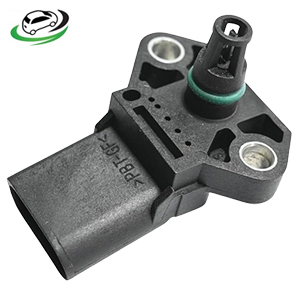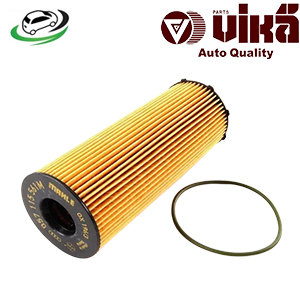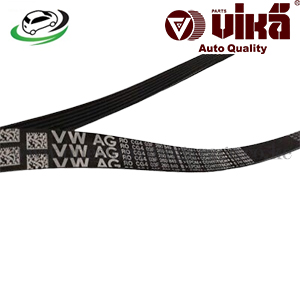Get V-ribbed belt drive belt AUDI 100 C4 Avant/A1 (8X1/8XK)/ A3 (8P1)/ A6 C4 (4A2)/ VW Jetta IV (162/163/AV3/AV2)/ Touran (1T3)/ Polo V (6R1/6C1) 03F260849A
The V-ribbed belt, also known as the serpentine belt or drive belt, is a critical component in modern vehicles, playing a crucial role in transferring power from the engine’s crankshaft to various auxiliary components. These components typically include the alternator, power steering pump, water pump, air conditioning compressor, and more. In this detailed guide, we will explore the construction, function, benefits, common issues, and maintenance of the V-ribbed belt, also known as the drive belt, to provide a comprehensive understanding of its importance in a vehicle’s overall performance.
Construction of the V-Ribbed Belt
The V-ribbed belt is designed to be durable, flexible, and efficient in transmitting power under various operating conditions. It typically consists of the following components:
- Ribs:
- Material: Usually made from a tough, wear-resistant rubber compound, often reinforced with synthetic fibers.
- Design: The ribs are designed in a V-shape, which allows them to grip the pulleys effectively. The number of ribs can vary depending on the belt’s application, with more ribs providing greater power transmission capacity.
- Tensile Cords:
- Material: Made from strong synthetic materials like polyester, Kevlar, or aramid fibers.
- Function: These cords provide the belt with its strength and resistance to stretching, ensuring it maintains the correct tension and alignment over its lifespan.
- Backing:
- Material: Typically a durable rubber or elastomer layer that protects the tensile cords and provides additional flexibility.
- Function: The backing layer helps the belt resist environmental factors like heat, oil, and chemicals, extending its durability.
- Cover Fabric:
- Material: Often a woven or knitted fabric embedded in the rubber.
- Function: This outer layer reduces wear and tear, enhances grip on the pulleys, and improves overall belt durability.
Function of the V-Ribbed Belt
The primary function of the V-ribbed belt is to transfer rotational power from the engine’s crankshaft to various engine accessories. The key functions include:
- Power Transmission:
- Efficient Operation: The V-ribbed belt transfers power from the crankshaft to multiple components, such as the alternator, power steering pump, water pump, and air conditioning compressor, ensuring they operate effectively.
- Synchronizing Components:
- Coordinated Functioning: By driving multiple components with a single belt, the V-ribbed belt ensures that all these systems work in harmony, which is critical for the smooth operation of the vehicle.
- Maintaining Tension:
- Tension Control: The belt works in conjunction with tensioners and idler pulleys to maintain the correct tension, preventing slippage and ensuring consistent power delivery.
- Reducing Noise and Vibration:
- Smooth Operation: The belt’s design helps minimize noise and vibration from the engine’s accessory drive system, contributing to a quieter and more comfortable driving experience.
Benefits of the V-Ribbed Belt
The V-ribbed belt offers several advantages over traditional belts, making it the preferred choice in modern vehicles:
- Compact Design:
- Space Efficiency: The V-ribbed belt allows for a more compact engine design by driving multiple components with a single belt, reducing the space required for the accessory drive system.
- Improved Efficiency:
- Reduced Friction: The belt’s design minimizes friction and slippage, leading to more efficient power transmission and better overall engine performance.
- Enhanced Durability:
- Longer Lifespan: Made from high-quality materials, the V-ribbed belt is more resistant to wear, stretching, and environmental factors, resulting in a longer service life compared to older belt designs.
- Simplified Maintenance:
- Ease of Replacement: Since the V-ribbed belt drives multiple components, it simplifies maintenance by reducing the number of belts that need to be checked, adjusted, or replaced.
- Lower Operating Costs:
- Cost-Effective: With fewer belts to maintain and replace, the V-ribbed belt contributes to lower overall maintenance and operating costs for the vehicle.
Common Issues with the V-Ribbed Belt
Despite its durability, the V-ribbed belt can develop issues over time, particularly if not properly maintained. Some common problems include:
- Belt Slippage:
- Causes: This can occur due to improper tension, worn-out pulleys, or oil contamination on the belt.
- Symptoms: Slippage often manifests as a squealing or chirping noise, particularly when starting the engine or during acceleration.
- Cracking or Fraying:
- Causes: Over time, the rubber material can dry out and crack due to heat, age, or exposure to harsh chemicals.
- Symptoms: Visible cracks or frayed edges on the belt indicate that it is nearing the end of its service life and needs replacement.
- Glazing:
- Causes: Glazing occurs when the belt overheats, often due to excessive slippage or tension issues, causing the belt’s surface to become smooth and shiny.
- Symptoms: A glazed belt may lose its ability to grip the pulleys effectively, leading to slippage and reduced performance.
- Misalignment:
- Causes: Misalignment of pulleys or tensioners can cause the belt to wear unevenly, leading to premature failure.
- Symptoms: A misaligned belt may make a whirring or whining noise, and visible signs of uneven wear on the belt can often be observed.
- Tensioner and Pulley Wear:
- Causes: Worn or faulty tensioners and pulleys can cause the belt to lose tension or become misaligned.
- Symptoms: Signs include unusual noises from the engine bay, inconsistent belt tension, or visible wobbling of the belt.
Maintenance of the V-Ribbed Belt
Proper maintenance of the V-ribbed belt is crucial for ensuring its longevity and the reliable operation of the vehicle’s accessory systems. Here are some maintenance tips:
- Regular Inspection:
- Visual Checks: Periodically inspect the belt for signs of wear, such as cracking, fraying, or glazing. Also, check for proper alignment and tension.
- Tension Inspection: Ensure that the belt maintains the correct tension. A belt that is too loose or too tight can cause various issues, from slippage to premature wear.
- Replace as Recommended:
- Scheduled Replacement: Follow the manufacturer’s recommended interval for belt replacement, typically ranging from 60,000 to 100,000 miles, depending on the vehicle.
- Proactive Replacement: If the belt shows signs of significant wear or damage, replace it immediately, even if it hasn’t reached the recommended mileage.
- Check Tensioners and Pulleys:
- Component Inspection: Regularly inspect the tensioners and pulleys for wear or damage, as these components are essential for maintaining proper belt tension and alignment.
- Lubrication: Ensure that the pulleys and tensioners are properly lubricated and free of debris that could interfere with their operation.
- Avoid Contamination:
- Keep Clean: Keep the belt and surrounding components clean and free from oil, coolant, or other contaminants that could degrade the rubber or cause slippage.
- Engine Bay Care: When performing engine work, take care to avoid spilling fluids on the belt. If contamination occurs, clean the belt promptly.
- Listen for Unusual Noises:
- Noise Diagnosis: Pay attention to any unusual noises from the engine bay, such as squealing, chirping, or whirring, which could indicate a belt issue.
- Professional Evaluation: If you hear such noises, have a professional mechanic evaluate the belt and accessory drive system to diagnose the problem accurately.
Follow us on Facebook for more parts.



